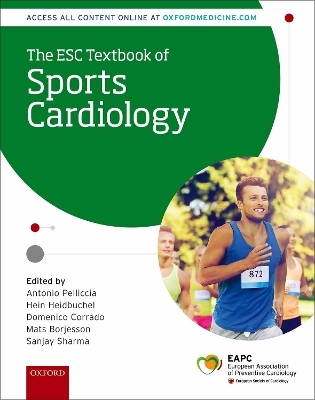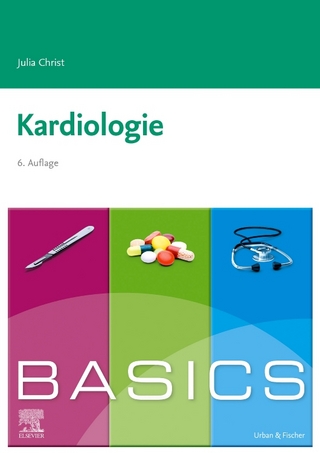
The ESC Textbook of Sports Cardiology
Oxford University Press (Verlag)
978-0-19-877974-2 (ISBN)
Sports and exercise have been intensely advocated as protective lifestyle measures which prevent or reduce the risk of severe health issues, including cardiovascular disease. More extreme forms of sports (for instance at high altitudes) have been identified as an important way of promoting cardiovascular adaptation, but have also been associated with adverse effects and even major cardiovascular events in predisposed individuals. Participating in more commonplace sports and exercise, such as football, may also increase a person's risk of cardiac events. This publication is timely in the light of a burgeoning number of clinical papers in the field.
The ESC Textbook of Sports Cardiology provides an overview of the detection and treatment of cardiovascular disease in elite athletes and young sports professionals in training, as well as prevention. It will be useful for clinical cardiologists, sports physicians, and general physicians alike. Split into 11 key areas in sports cardiology, ranging from sudden cardiac death in athletes to the most common cardiovascular abnormalities seen in athletes, and to the effects of substance abuse and doping, the text is an invaluable resource covering all aspects of sports cardiology.
Access to the digital version of the textbook is included with purchase of the printed version. Highly illustrated with embedded multimedia features, together with cross-referenced links to related content and primary research data in major journals in the field, the digital version provides users with a dynamic and forward-thinking resource.
The ESC Textbook of Sports Cardiology is the second textbook from the European Association of Preventive Cardiology (EAPC) and aligns with ESC clinical practice guidelines and EAPC recommendations and position papers.
Antonio Pelliccia, Institute of Sports Medicine and Science of the Italian National Olympic Committee, Rome, Italy, Hein Heidbuchel, University of Antwerp and University Hospital Antwerp, Antwerp, Belgium, Domenico Corrado, Cardiovascular Medicine, University of Padova, Italy, Mats Borjesson, Department of Cardiology, Karolinska Institute, Sweden, Sanjay Sharma, Department of Cardiology, St George's Hospital, London, UK
Section 1: Physiology of Cardiovascular response to exercise and cardiac remodelling
1.1 - Cardiovascular induced by exercise
1.1.1: Sanjay Sharma and Andrew D'Silva: Physiology of exercise
1.2 - Long term adaptation to exercise: athlete's heart and vascular adaptations
1.2.1: Stefano Caselli and Antonio Pelliccia: Structural and functional adaptations in the athlete's heart
1.2.2: Nabeel Sheikh: Impact of sporting discipline, gender, ethnicity and genetics on the athlete's heart
1.2.3: Graham Stuart and Guido E Pieles: The athlete's heart in children and adolescents
1.2.4: Stephan Gielen, M. Harold Laughlin, and Dirk J. Duncker: The vascular remodelling
Section 2: Clinical evaluation of the athlete's heart
2.1 - History and physical examination
2.1.1: Maurizio Schiavon, Domenico Corrado, and Alessandro Zorzi: History and physical examination
2.2 - The electrocardiogram in the athlete
2.2.1: Alessandro Zorzi and Domenico Corrado: The electrocardiogram in the athlete
2.2.2: Ricardo Stein and Victor Froelicher: Common ECG patterns of the athlete's heart
2.2.3: Michael Papadakis and Harshil Dhutia: Overlap ECG patterns in athlete's heart and cardiomyopathies
Section 3: Additional testing in the evaluation of the athlete's heart
3.1 - Exercise testing
3.1.1: Paolo Emilio Adami and Marco Guazzi: Protocols of exercise testing in athletes and cardiopulmonary testing: assessment of the fitness
3.1.2: Francois Carre and Frederic Schnell: Evaluation of ischemia, blood pressure, QT interval and arrhythmias
3.2 - Arrythmias registration
3.2.1: Mahdi Sareban and Josef Niebauer: Ambulatory (24-h Holter monitoring, event recorders) and signal-averaged ECG for arrhythmia registration in the athlete's heart
3.2.2: Matthias Antz: Class-1 anti arrythmic drug provocation test
3.2.3: Matthias Antz: Electrophysiological study
3.3 - Imaging of the athlete's heart: anatomical and functional
3.3.1: Stefano Caselli and Flavio D'Ascenzi: Echocardiogram: morphologic and functional evaluation including new echocardiographic techniques
3.3.2: Guido Claessen and Andre La Gerche: Cardiac Magnetic Resonance Imaging
3.3.3: Stephan Möhlenkamp: Coronary computed tomography
3.3.4: Stephan Möhlenkamp: Nuclear imaging
3.3.5: Stephan Möhlenkamp: Coronary angiography
3.4 - Genotyping
3.4.1: Silvia Priori: Indications for genetic testing in athletes and its application in daily practice
Section 4: Cardiac diseases of interest in sports cardiology
4.1 - Myocardial and coronary diseases
4.1.1: Sanjay Sharma and Aneil Malhotra: Hypertrophic Cardiomyopathy in Athletes
4.1.2: Gaetano Thiene, Kalliopi Pilichou, and Cristina Basso: Arrhythmogenic Cardiomyopathy and Sudden Death in Young Athletes: Causes, Pathophysiology and Clinical features
4.1.3: Martin Halle: Myocarditis in athletes
4.1.4: Andrew D'Silva and Sanjay Sharma: Differentiating Athlete's Heart from Left Ventricular Noncompaction Cardiomyopathy
4.1.5: Cristina Basso, Carla Frescura, and Gaetano Thiene: Congenital coronary artery anomalies
4.2 - Valvular and aortic disease
4.2.1: Christian Schmied and Sanjay Sharma: Mitral Valve Prolapse in Relation to Sport
4.2.2: Natesa Pandian and Benjamin S. Wessler: Bicuspid Aortic Valve Disease and Competitive Sports: Key Considerations and Challenges
4.2.3: Guido E Pieles and A Graham Stuart: The Athlete with Congenital Heart Disease
Section 5: Rhythm disorders of interest in sports cardiology
5.1: Arthur Wilde and Nicole M Panhuyzen-Goedkoop: Channelopathy in Athletes
5.2: Lluis Mont and Eduard Guasch: Ventricular Tachyarrythmias
5.3: Mattias Wilhelm: Supraventricular tachyarrythmias
5.4: Pietro Delise: Preexcitation and Conduction Abnormalities
Section 6: Sudden Cardiac Death in athletes
6.1: Jonathan Drezner and Kimberly Harmon: Incidence of Sudden Cardiac Death in Athletes
6.2: Cristina Basso and Gaetano Thiene: Cardiovascular causes of sudden death in athletes
6.3: Paul Thompson: The Risk, Etiology, Clinical Features, Management & Prevention of Exercise-related Sudden Cardiac Death and Acute Cardiac Events in Adult Athletes
6.4 - Less frequent causes of sudden cardiac death
6.4.1: Erik Solberg and Paolo Adami: Less frequent causes of SCD (commotio cordis, aortic rupture). Non-cardiac causes (drug abuse, hyperpyrexia, rhabdomyolysis, sickle cell anemia, asthma, extreme environmental conditions (heat, cold, altitude) PART ONE
6.4.2: Erik Solberg and Paolo Adami: Less frequent causes of SCD (commotio cordis, aortic rupture). Non-cardiac causes (drug abuse, hyperpyrexia, rhabdomyolysis, sickle cell anemia, asthma, extreme environmental conditions (heat, cold, altitude) PART TWO
6.5: Domenico Corrado and Alessandro Zorzi: Preparticipation screening of young competitive athletes
6.6: Luc Vanhees and Mats Borjesson: Cardiovascular screening in adult/senior competitive athletes
6.7: Werner Budts, Massimo Chessa, and Javier Fernandex Sarabia: Cardiovascular screening of children and adolescent athletes
Section 7: Sports eligibility in athletes with cardiac abnormalities
7.1: Antonio Pelliccia, Hein Heidbuchel, Domenico Corrado, Sanjay Sharma, and Mats Borjesson: Criteria and considerations relative to safe sport participation in athletes with cardiac abnormalities
Section 8: Excercise Prescription for cardiovascular health
8.1: Massimo Piepoli, Mats Börjesson, and Mikael Dellborg: Criteria and considerations relative to safe sport participation in athletes with cardiac abnormalities
8.2: Stephan Müller, Flavia Baldassarri, Julia Schönfeld, and Martin Halle: Monitoring exercise programs and improving CV performance
Section 9: Cardiac safety at sports facilities
9.1: Mark Link and Mark Estes III: Resuscitation on the field: basic and advanced life support and automatic external defibrillators (AED)
9.2: Mats Börjesson, Luis Serratosa, and Efraim Kramer: Cardiac safety at sports events: the medical action plan
9.3: Erik Solberg, Jakob Johansson, and Alessandro Biffi: Cardiac safety at fitness centres
Section 10: Cardiovascular effects of substance of abuse/doping
10.1: Josef Niebauer and Carl-Johan Sundberg: World Anti-Doping Agency (WADA) and International Olympic Committee (IOC) list of prohibited substances and methods and their cardiovascular effects
10.2: Ronald Maughan and SM Shirreffs: Nutrition and ergogenic aids prescription for competitive athletes
Section 11: Hypertension in athletes
11.1: Stefano Caselli and Josef Niebauer: Diagnosis and management of hypertension in athletes
| Erscheinungsdatum | 14.05.2019 |
|---|---|
| Reihe/Serie | The European Society of Cardiology Series |
| Verlagsort | Oxford |
| Sprache | englisch |
| Maße | 283 x 225 mm |
| Gewicht | 1506 g |
| Themenwelt | Medizinische Fachgebiete ► Innere Medizin ► Kardiologie / Angiologie |
| Medizin / Pharmazie ► Medizinische Fachgebiete ► Sportmedizin | |
| ISBN-10 | 0-19-877974-7 / 0198779747 |
| ISBN-13 | 978-0-19-877974-2 / 9780198779742 |
| Zustand | Neuware |
| Haben Sie eine Frage zum Produkt? |
aus dem Bereich


